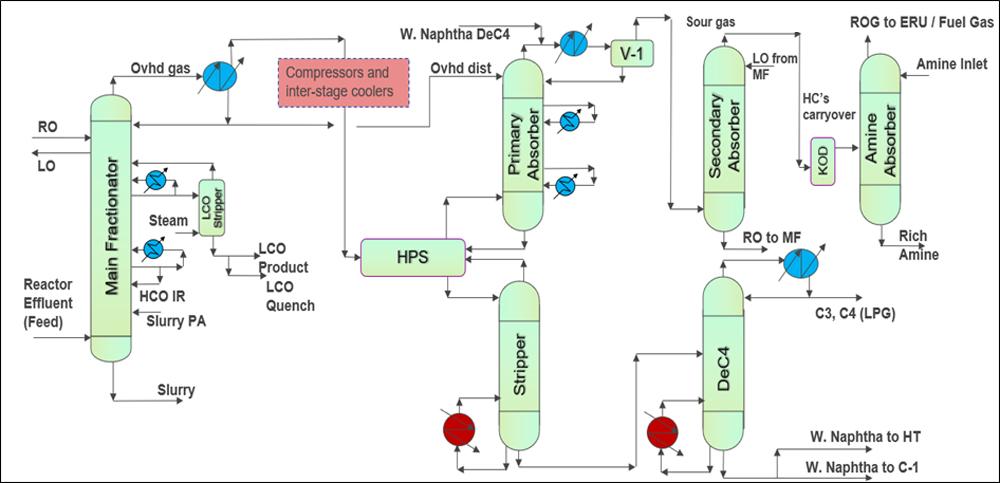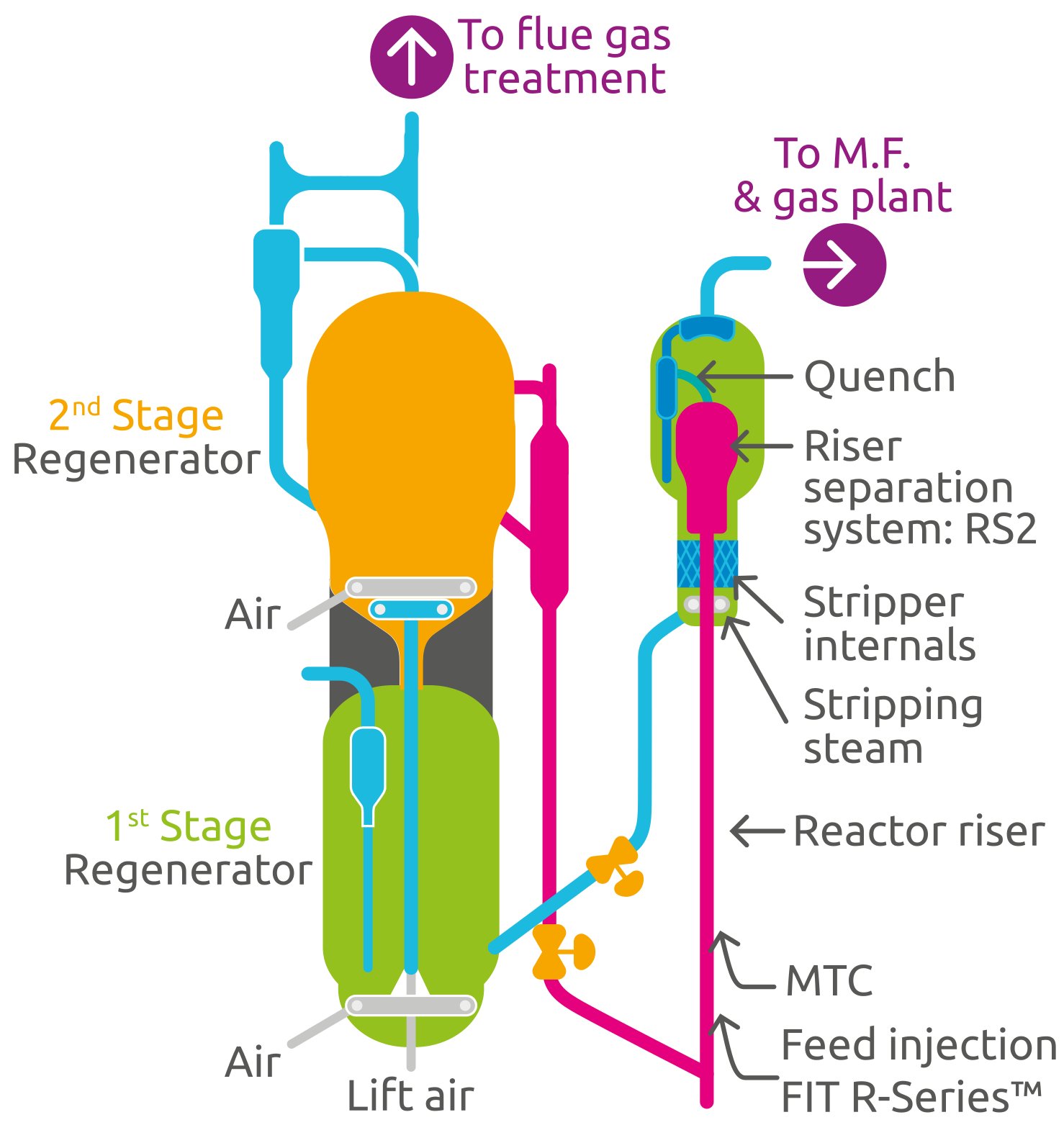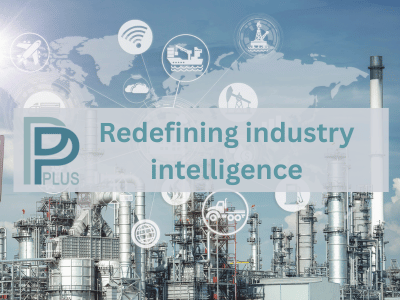Technology Summary
Axens’ R2R™ (Reactor-to-Regenerator) fluid catalytic cracking technology is engineered for the conversion of heavy hydrocarbon residues, specifically targeting feeds with elevated levels of metals (Nickel, Vanadium, Sodium) and high Conradson Carbon Residue (typically above 3 wt.%). The core of the R2R™ process is its sequential, dual-stage regenerator system. The first regenerator oxidizes 30–70% of the coke and removes most hydrogen under controlled, mild partial-combustion conditions, which suppresses vanadium’s conversion to corrosive vanadic acid and limits overall catalyst deactivation. The partially regenerated catalyst is then transferred to a second regenerator operating in complete combustion mode, removing the remaining coke and restoring full catalytic activity under a dry, high-temperature atmosphere.
This dual-stage regeneration design facilitates thermal management, retards catalyst aging, and enhances metals tolerance, making it feasible to maintain high catalyst circulation rates and process energy-dense or contaminated feeds. Integration with an advanced short-residence-time riser reactor and proprietary feed injection results in rapid vaporization and cracking, optimizing product selectivity towards light olefins, gasoline, and LPG while minimizing secondary cracking and over-oxidation of coke. Overall, the system ensures high feed conversion efficiency with extended catalyst life and reduced environmental emissions due to improved coke combustion control and optional catalyst coolers for further heat regulation.
Detailed Process Description
Feedstock
Feed Injection
- Proprietary high-impact feed injector design ensures rapid atomization and uniform mixing of oil, steam, and hot catalyst—crucial for complete vaporization and optimal contact in the riser.
Reactor System
- Main Riser:
- Operation: Short contact time (seconds), high catalyst-to-oil ratio (>6:1 typical), riser outlet temperatures of 510–530°C.
- Control: Mixed Temperature Control (MTC) recycles pre-heated catalyst to manage riser thermal profile, offering precise temperature gradients along the riser length.
- Separation: RS2™ high-containment riser termination devices are used for very rapid catalyst disengagement, minimizing post-riser thermal/catalytic cracking.
- Optional PetroRiser™:
- Operation: A parallel high-severity riser (outlet T up to 550°C) selectively cracks light/medium naphtha or olefinic recycle streams under more severe conditions for enhanced propylene and light olefins yield.
Reaction Chemistry
- Catalysis: Catalysts formulated for metals tolerance—USY-type base stabilized with metal traps and anti-deactivation functionalities; ZSM-5 additive introduced for maximal propylene targeting.
- Chemistry:
- Primary catalytic cracking reactions parametrize the selective cleavage of larger hydrocarbon molecules into lighter fractions (LPG, naphtha/gasoline, light olefins, fuel gas), while restricting over-cracking/coke formation via optimized residence time and temperature.
- In residue applications, severe operation (high temperature, high activity, high circulation) enables light olefin yields competitive with lighter gas oils.
Stripper Unit
- Hardware: High-efficiency structured (KFBE™) packing for intensive steam stripping at lower steam usage.
- Function: Maximizes gasoline and LPG recovery by displacing entrained hydrocarbons before catalyst enters regeneration.
- Typical product Yields: (as provided for the R2R™ RFCC operation at Ruwais refinery)
- Fresh feed
to the reactor:
|
981 m³/h
|
|
|
57m³/h; (heaviest cut, for fuel blending or carbon black precursor) |
|
|
1412m³/h; this fraction forms the main medium distillate stream, valuable as diesel blendstock after further treatment. |
|
|
287m³/h LCO product, with additional heavy naphtha/cycle oil cuts. |
|
|
2000m³/h (LCN),
with ~218–242m³/h wash oil. |
- Light Gasoline / LPG, Propylene, Fuel Gas
|
These light ends are separated further downstream in absorbers and gas concentration columns. |
Figure 1 - Typical main fractionator and gas concentration system (Ruwais refinery R2R™ RFCC)

Catalyst Regeneration (Two-Stage Design)
- First Regenerator:
- Mode: Operates under controlled partial combustion (30–70% coke burned; almost all hydrogen removed; lower temperatures).
- Purpose: Limits oxidation of vanadium, suppresses vanadic acid formation, and retards irreversible catalyst degradation.
- Second Regenerator:
- Mode: Receives partially regenerated catalyst for final coke burn-off in a dry, high-temperature atmosphere, restoring full catalyst activity.
- Effect: Catalyst makeup is minimized, system tolerates much higher metals/CCR loads than single-stage FCC configurations.
- Catalyst Cooling: Optional heavy-duty external coolers (>50MW, fully turndown-controllable) support process energy balance and high-severity operation.
Emissions & Mechanical Configuration
- Design: All major vessels and lines employ cold wall construction to minimize thermal stress and maximize long-term mechanical integrity and uptime.
- Emissions: Fully compatible with modern flue-gas scrubbing and NOx/SOx reduction systems to meet stringent environmental standards.
Summary Table and System Features
Feature/
Component |
Description |
| Feedstock |
VGO, AR/VR, heavy residues
with high metals and CCR (>3 wt.%) |
Reactor
Section |
High-impact feed injectors; RS2™ catalyst separation; PetroRiser™ for recycle/propylene |
| Stripper |
KFBE™ high-efficiency packing
for improved stripping and low steam use |
Regenerators
(2-stage) |
Stage 1: Mild, partial combustion;
Stage 2: Dry, complete burn; optimal for high metals/CCR |
| MTC System |
Mixed Temperature Control for optimal
riser rofiling and process flexibility |
Catalyst
Cooling |
External coolers with >50MW capacity,
for energy management and flexible operation |
Mechanical
Design |
Cold wall, high reliability; low maintenance |
Emissions
Control |
Supports advanced flue-gas
scrubbing/NOx/SOx reduction |
Typical Riser
Temperatures |
510–530°C (main);
up to 550°C (PetroRiser™) |
Contact
Time |
Seconds (short),
high catalyst/oil ratio |
| Regenerator 1 |
Partial combustion (30–70% coke),
limits vanadic acid and thermal stress |
| Regenerator 2 |
Complete combustion in dry air,
fully restores catalyst |
| Feed Metals Handling |
Proven >25ppm Ni+V;
limits on other toxic metals variably specified |
Performance, Efficiency, and Mass Balance
- Flexibility: Handles massive feed quality variance—residue or VGO/distillate blends; quick changeover between gasoline and propylene modes.
- Product Slate: High light olefins (propylene, C4’s), high-octane gasoline, aromatics; propylene yields up to 14–18 wt% with appropriate recycle/feed and ZSM-5 addition. Gasoline mode can be optimized for yield >50 wt%.
- Metals/Hydrothermal Robustness:
- Two-stage regeneration protects catalyst integrity, enabling high turnover numbers and lower replacement rates.
- External catalyst coolers decouple air and catalyst circulation—enabling energy and yield optimization.
- Operating Efficiency: Advanced separation prevents overcracking and increases selectivity. High reliability and low maintenance design.
- Environmental Performance: Regeneration optimized for minimal emissions; supports installation of latest flue gas scrubbing systems and meets stringent environmental requirements; documented reductions in SOx/NOx via integration with hydrotreating for pretreatment and by lower regenerator temperature enabling less NOx formation.
Economic Performance and Commercial References
- CAPEX: Claimed to be comparable or lower than alternative RFCC units at scale due to innovative reactor/regenerator integration, with high reliability and low maintenance.
- OPEX: Claim of low catalyst and energy consumption due to optimized regeneration and feed flexibility, and of lowered catalyst makeup, high distillate or propylene selectivity.
- Commercial Scale: Over 60 grassroots R2R units licensed globally; >250 revamps/upgrades including non-Axens original designs. Large installations include Adnoc (U.A.E., 127,000 bpsd), PRefChem (Malaysia, 140,000 bpsd), and many others in Asia, the Middle East, and Europe.
- Integration Synergy: Often paired with Axens’ Hyvahl™ residue hydrotreating for feed pretreatment—enabling higher FCC yield, lower emissions, improved metals management, and better integration with petrochemicals complexes.
References
- Axens. Oil Refining - Catalytic Cracking
- Axens, Commercial Bulletin, FCC/R2R™, VGO & Resid Fluid Catalytic Cracking Technology
- IFP Energies nouvelles (IFPEN). Our Solutions for Fuels.
- Jack. Jan 28, 2019. Resid Cracking Process by Axens and Shaw. Oil & Gas Process Engineering
- Sonia Plantier. Jul 19, 2017. Axens' Iran Seminar, Tehran: Hyvahl™ & RFCC Synergy. VCMStudy.ir
- Axens. Catalysts, Adsorbents & Gradings Technology - Residue Hydrotreating Catalysts
- V. Rajaretnam et al.. Jul. 2025. RFCCU revamp to improve main fractionator gascon column performance and minimize propylene losses to refinery offgas. Hydrocarbon Processing.
- A barrel full. Jul 21, 2008. Axens Awarded Basic Engineering Design and Licenses for the Takreer Ruwais Refinery Expansion Project. Killajoules.
- Jun 22, 2015. Petronas Lets Technology Contract for RAPID Project. Oil&Gas Journal














